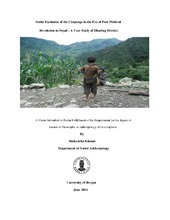Social exclusion of the Chepangs in the era of post political revolution of Nepal- A case study of Dhading District
Master thesis
Permanent lenke
https://hdl.handle.net/1956/8507Utgivelsesdato
2014-06-19Metadata
Vis full innførselSamlinger
Sammendrag
The main objective of the present work is to investigate the mechanisms and processes of social exclusion of the Chepang people, one of the highly marginalized ethnic groups of Nepal. To do so, I examined the Chepang's livelihoods, ethnic identity and their access to natural resources with deprivation perspective. Even after the post political revolution era of Nepal, the Chepangs still experience a precarious livelihood, and ethnic erosion and they are disentitled over natural resources. The main finding of the research is that poverty is an inevitable cause of their marginalized and excluded situation. I explored that the government of Nepal discriminated the Chepangs as uncivilized and wasteful in terms of profit instead of state favors for their enhancement. Patron-client relationship of the Chepangs to dominant groups and NGOs make them culturally subordinated and economically vulnerable. Disparities of power and wealth and unequal exchanges between the Chepangs and Brahmins benefitted the Brahmins but it made the Chepangs impoverished. Furthermore, the roles of the NGOs was like patron as it worked with predetermined ideas which could not eradicate the poverty but rather it made the Chepangs dependent by supplying the goods for short term consumption. The geographical location of Chepang villages is also a strong factor of their marginalization due to the lack of employment opportunities and infrastructure development. The results indicate that the Chepangs are socially excluded not due to their own defects but because of spatial disparity, institutionalized inequalities and cultural influence. Key words: Exclusion, Poverty, State, Livelihood, Ethnic identity, Natural resources
